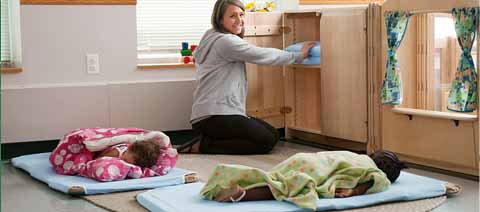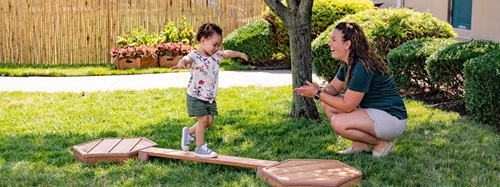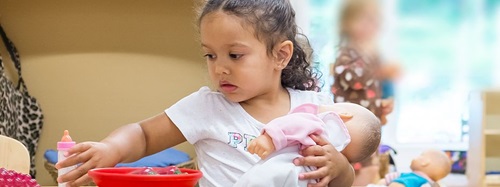Creating an Environment for Safe and Healthy Sleep in Child Care Programs
| November 2013Along with nutrition, physical activity, and secure attachments, sleep is a basic requirement for a child’s growth and brain development. Sleep is important for health and wellness, especially for growing infants and young children. Unfortunately, the amount of time children spend sleeping seems to be declining.
If only sleep-deprived children just got drowsy and went to sleep, but generally this is not the case. Sleep-deprived children are often impulsive, hyperactive, aggressive, overly-emotional, inattentive, and are more likely to hurt themselves. In other words, they fall apart. A recent study found that children who don’t get enough sleep can mistakenly be thought to have attention deficit hyperactivity disorder (ADHD), and children who don’t have a regular bedtime are more likely to have ADHD-like behaviors (Pressman & Imber, 2011). Poor sleep is also linked to obesity and impaired immune function.
Healthy practices for sleep, including those that reduce the risk of Sudden Infant Death Syndrome (SIDS) and Sudden Unexplained Infant Death (SUID), support child health and family well-being. By becoming knowledgeable about sleep, you can help busy families lay the foundation for lifelong healthy sleep habits.
How Much Sleep Do Children Need?
There is a range of how much sleep each child needs, and most children fall in this range:
- Newborns sleep about 16-20 hours divided over the 24-hour day and there is not much difference between daytime and nighttime sleep patterns.
- Infants sleep about 13 hours by 3 months and can sleep 5-6 hours in a row at night. Parents and caregivers guide the process of forming the foundations of sleep habits by establishing routines for nighttime sleep and daytime naps. By 6-12 months, most babies sleep about 3 hours during the day (usually split between a morning and afternoon nap) and 9-11 hours at night.
- Toddlers from ages 1-3 usually sleep 10-13 hours, including a daytime nap.
- Preschoolers ages 4-5 usually sleep 10-12 hours. Some children will give up daytime naps sooner, but will still benefit from a quiet rest time during the day. Giving up a daytime nap often means an earlier bedtime for a preschooler (Kidshealth, 2011).
Sleep Habits and Routines
Creating a calm atmosphere and following a regular routine helps children get ready to sleep. Ideally, infants and children should be put in a crib or on a cot when tired and sleepy but still awake. This helps children learn skills to selfsoothe so they are better able to fall asleep independently. Providing cues for sleep, such as soft music or a sleep time story, is reassuring for young children.
Many factors can change a child’s sleep patterns. A child may sleep more during growth spurts or after a busy weekend with friends and family. A child may sleep poorly when teething or ill with a stuffy nose, fever, or earache. These are all a normal part of childhood, and parents and teachers are wise to be flexible and understanding about these kinds of variables in a child’s sleep patterns.
Factors affecting children’s sleep habits, such as physical activity, bedtime routines, and media use (video games, movies, TV, cell phones), can be adjusted to optimize healthy sleep for children. Little is known about how media use affects children’s sleep except to say that children are using media more, at younger ages, and seem to be sleeping less. A research brief from the Kaiser Foundation notes that viewing exciting or violent media just before bedtime can make it hard for children to fall asleep (Zimmerman, 2008). Children who spend more time in front of a screen may also be missing out on opportunities for physical activity, which is linked to falling asleep faster and sleeping longer (Nixon et al., 2009).
Working with Families Around Sleep Issues
The best way to tell if a child is getting enough sleep is how they look and act. When a child seems overtired (i.e. cranky, irritable, aggressive, uncooperative, over-emotional, hyperactive, or inattentive), share your observations with the parents. The morning health check is a good time to talk about sleep. Ask about media use, bedtime routines, nighttime waking, and if the parent has to wake the child in the morning. You might suggest that parents keep a sleep diary for a few days. A sample sleep diary can be found on the University of Michigan website (see Resources).
Cultural differences and practices, such as co-sleeping and bed-sharing, can affect how safely and soundly children and parents sleep. The American Academy of Pediatrics (AAP) recommends that infants sleep in the same room as parents, but not in the same bed (AAP, 2011). Some working families want more time with their children in the evening and may postpone bedtime. Others may ask you to minimize or skip the daytime nap so that the child goes to bed earlier. Be sensitive to differences, but always keep the well-being of the child in mind. Share information about sleep health and safety in an objective and nonjudgmental way. For severe sleep issues that don’t respond to simple adjustments in routines and practices, refer parents to their health care provider since some medical conditions can cause sleep problems.
Safe Sleep Environments and Practices for Infants in Child Care Programs
An environment that is safe and supports healthy sleep is a top priority for infant care programs. Sadly, about 1 in 5 SIDS deaths occurs while an infant is in the care of someone other than the parent. Some of these deaths happen in child care programs when babies who are used to sleeping on their backs at home are placed on their stomachs to sleep. Since the AAP ‘back-to-sleep’ recommendations took effect in 1992, the SIDS rate has dropped by more than 50 percent. But at the same time, other causes of unexpected sleep-related deaths including suffocation, asphyxia, and entrapment have increased (AAP, 2011b). Recently, AAP revised and expanded its safe sleep recommendations to reduce the risk of all sleeprelated infant deaths. In addition, Caring for Our Children, the National Standards for Health and Safety in Out of Home Care (AAP & APHA, 2011) includes updated standards for safe sleep in child care programs. The following summarizes the updated recommendations for safe sleep environments and practices for infants in child care programs:
- Always place infants on their backs to sleep.
- Use a firm mattress, covered with a fitted sheet, in a crib that meets the standards from the U.S. Consumer Product Safety Commission (CPSC).
- Keep the crib free from soft objects, toys, bumper pads, pillows, and blankets.
- Maintain a distance of at least 3 feet between cribs.
- Remove bibs, necklaces, and garments with ties or hoods.
- Maintain a room temperature that is comfortable for a lightly-clothed adult and provide good ventilation and air circulation.
- Infants should be dressed in no more than one layer more than an adult would wear.
- One-piece sleepers may be used for warmth.
- Use a pacifier when placing an infant for sleep, if provided by the parent.
- Keep sleeping infants close by for monitoring and provide active supervision by sight and sound.
- Assign a crib to each infant; place only one infant in a crib.
- Do not place infants to sleep on a bed, cushion, couch, armchair, bean bag chair, sheepskin, or pillow because of the risk of entrapment or suffocation.
- Sitting devices such as car seats, strollers, swings, bouncy seats, high chairs, play pens, and infant slings should not be used for routine sleep.
- If an infant falls asleep anywhere other than a crib, move the infant right away. If an infant arrives in a car seat asleep, move the infant to a crib upon arrival.
- Blankets and other items should not be attached to or hung on the side of the crib.
- Pacifiers should not be attached to a ribbon or string to be worn around the infant’s neck or fastened to an infant’s clothing.
- Infants should not be put to sleep with a bottle.
- Swaddling infants is not recommended in child care programs.
- No smoking should be allowed around infants or in areas where infants sleep.
Infants should be placed on their backs to sleep until 12 months old. Individual medical conditions might cause a physician to recommend other sleep positions, but this is rare and a doctor’s signed waiver is required. Once infants can easily roll back and forth, allow them to remain in the sleep position they assume. Breastfeeding and up-to-date immunizations are linked to lower SIDS rates, so encourage mothers to breastfeed and monitor the immunization status of infants. Also, be sure to provide daily supervised tummy time when an infant is awake (AAP, 2011a).
Adults’ Sleep Health and Optimal Job Performance
Lack of sleep can reduce adults’ productivity and increase the chance of accidents and mishaps. It also can lead to problems with mood, behavior, and relationships. At the same time, adequate sleep for staff improves health, quality of life, job satisfaction, and safety in the workplace. Since young children need adults to be patient and to respond in a predictable manner, the overall quality of your program depends on adults sleeping well.
Make Healthy Sleep a Priority
Healthy sleep and safe sleep practices have far-reaching consequences for children, families, and staff. Do yourself and the families in your program a favor by making healthy and safe sleep a priority!
References
American Academy of Pediatrics (AAP). (2011). SIDS and other sleep-related infant deaths: Expansion of recommendations for a safe infant sleeping environment. Pediatrics, 128, 1341-1367. Elk Grove, IL: American Academy of Pediatrics Task Force on Sudden Infant Death Syndrome. Retrieved from http://pediatrics. aappublications.org/content/128/5/ e1341.full
American Academy of Pediatrics, American Public Health Association, & National Resource Center for Health and Safety in Child Care and Early Education. (2011). Caring for our children: National Health and Safety Performance Standards for Early Care and Education Programs (3rd Edition). Elk Grove Village, IL & Washington, DC: American Academy of Pediatrics, American Public Health Association, & National Resource Center for Health and Safety in Child Care and Early Education.
Boyse, K. (2010, November). Sleep problems. Retrieved 11/6/11 from www.med.umich.edu/yourchild/ topics/sleep.htm
Kidshealth. (2011). All about sleep. Nemours Foundation. Retrieved 11/6/11 from http://kidshealth.org/parent/ general/sleep/sleep.html
Nixon, G. M., Thompson, J. M. D., Han, D. Y., Becroft, D. M. O., Clark, P. M., Robinson, E., Waldie, K. E., Wild, C. J., Black, P. N., & Mitchell, E. A. (2009, July). Falling asleep: The determinants of sleep latency. Archives of Diseases in Childhood, 94, 686-689. London: BMJ Publishing. Pressman, R. M., & Imber, S. C. (2011). Relationship of children’s daytime behavior problems with bedtime routines/ practices: A family context and the consideration of Faux-ADHD. American Journal of Family Therapy, 39(5), 404-418.
Zimmerman, F. (2008). Children’s media use and sleep problems: Issues and unanswered questions. Menlo Park, CA: Kaiser Family Foundation.
Copyright © Exchange Press, Inc. Reprinted with permission from Exchange magazine.All rights reserved. Visit us at www.ChildCareExchange.com or call (800) 221-2864.






